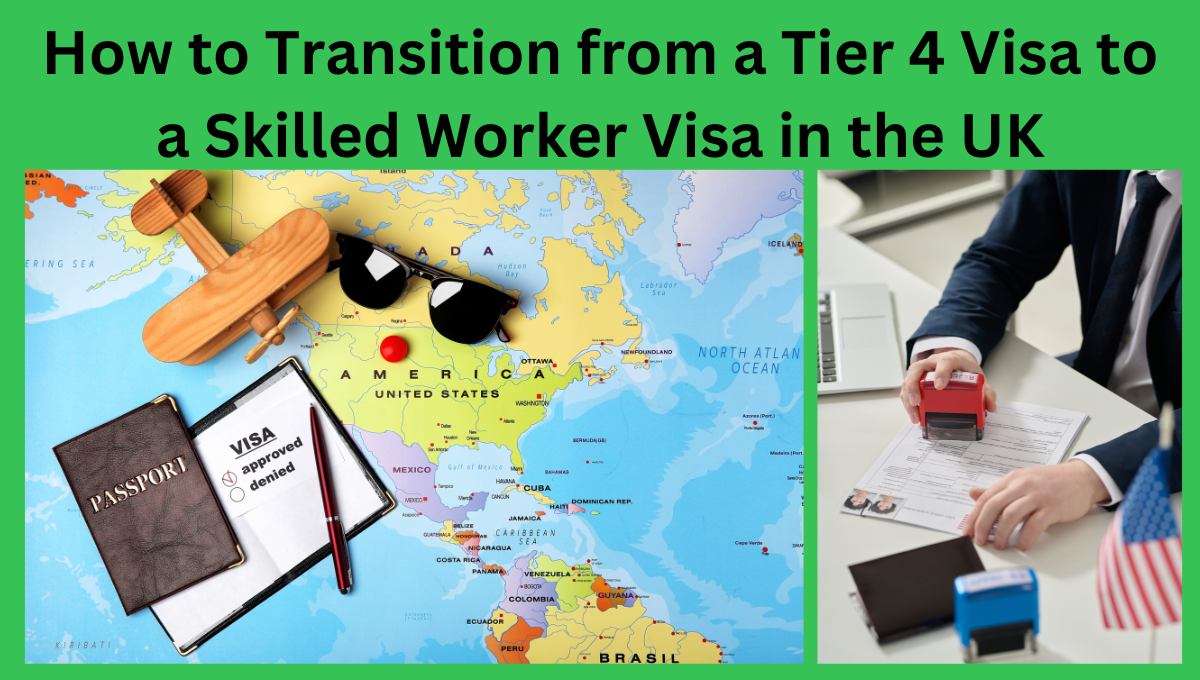How to Transition from a Tier 4 Visa to a Skilled Worker Visa in the UK
Meta Description
Find out how to change your UK Tier 4 visa to a skilled worker visa. Find detailed instructions, qualifying requirements, and important advice.
Overview
An Overview of Skilled Worker and Tier 4 Visas
The Benefits of Making the Change
Knowing the Requirements for Visas
Qualifications for Holders of Tier 4 Visas
Requirements for the General Skilled Worker Visa
How to Change Your Tier 4 Visa to a Skilled Worker Visa
Getting a Job Offer in Step One
Step 2: The Process of Employer Sponsorship
Step 3: Pay Limits and Exclusions
Step 4: Language Requirements in English
Putting in Your Application in Step Five
Step 6: Necessary Records
Step 7: Timelines and Application Fees
Overcoming Typical Obstacles
Absence of Employer Support
Fulfilling Financial Needs
Benefits of a Visa for Skilled Workers
Opportunities for Career Advancement
Qualifications for Long-Term Residency
Advantages for Reliants
Errors to Steer Clear of During the Transition
Misunderstanding the Rules
Inaccurate or lacking documentation
FAQs
View below
In conclusion
Last Words of Advice and Motivation
Overview
An Overview of Skilled Worker and Tier 4 Visas
International students can study in the UK with the Tier 4 (Student) Visa. Changing to a skilled worker visa after finishing your education provides a route to employment and permanent residency in the UK. The skilled worker visa is designed for people who contribute to the UK workforce and have specific talents.
The Benefits of Making the Change
You can find work, acquire work experience, and possibly live in the UK permanently by switching to a skilled worker visa. Additionally, it offers stability and access to a variety of benefits, including healthcare and help for dependents.
Knowing the Requirements for Visas
Qualifications for Holders of Tier 4 Visas
You need to fulfill the following requirements in order to transition:
own a current Tier 4 Visa.
possess a bachelor’s, master’s, or comparable degree from the United Kingdom.
Obtain an offer of employment from a UK-licensed company.
Requirements for the General Skilled Worker Visa
Among the prerequisites are:
offer of employment from a recognized company.
yearly salary criterion of £26,200 (or modified rates for particular roles).
proficiency in the English language.
How to Change Your Tier 4 Visa to a Skilled Worker Visa
Getting a Job Offer in Step One
Finding a job that fits your qualifications and skills is the first step. To find chances, use job boards, networking, and career services offered by universities.
Step 2: The Process of Employer Sponsorship
In addition to providing you with a Certificate of Sponsorship (CoS) outlining your responsibilities and pay, your employer must possess a sponsorship license.
Step 3: Pay Limits and Exclusions
Your position must pay the minimum wage in order to be eligible:
The general barrier is £10.75 per hour, or £26,200.
lower rates for new hires or occupations experiencing a scarcity.
Step 4: Language Requirements in English
Demonstrate your expertise by:
completing an English-taught degree.
passing a recognized English language exam, such as the IELTS.
Putting in Your Application in Step Five
Apply online for a skilled worker visa through the UK Home Office website. Make sure all of the information is correct and comprehensive.
Step 6: Necessary Records
Get the following paperwork ready:
travel ID or passport.
Reference number for the Certificate of Sponsorship.
Evidence of fluency in the English language.
academic credentials.
monetary proof (if needed).
Step 7: Timelines and Application Fees
£610 to £1,408 for an application, depending on the length of the position.
£624 is the annual Immigration Health Surcharge.
Three weeks is the average processing time.
Overcoming Typical Obstacles
Absence of Employer Support
Because of the perceived complexity of sponsorship, several employers are hesitant. Resolve their issues by emphasizing your worth and provide information on the advantages of sponsorship.
Fulfilling Financial Needs
Examine positions in shortage occupations or ask about employer-sponsored financial assistance if budgetary constraints are an issue.
Benefits of a Visa for Skilled Workers
Opportunities for Career Advancement
You can access professional training, a wide network, and greater job chances with a skilled worker visa.
Qualifications for Long-Term Residency
You can apply for indefinite leave to remain after five years, which will lead to UK citizenship.
Advantages for Reliants
In the UK, dependents like wives and kids are welcome to join you and take advantage of employment and educational opportunities.
Errors to Steer Clear of During the Transition
Misunderstanding the Rules
Avoid making assumptions and make sure you fully comprehend the conditions for obtaining a visa.
Inaccurate or lacking documentation
Verify every document you submit twice to avoid delays or rejections.
FAQs
- If I don’t finish my degree, may I change to a skilled worker visa?
No, in order to be qualified, you must finish your degree program.
- How long can I use a skilled worker visa to stay in the UK?
You have the option to extend your stay for an additional five years.
- What occurs if the pay threshold is not met at my job?
If you work in a shortage occupation, for example, you might still be eligible.
- If I have a Tier 4 visa, can I still apply for a Skilled Worker visa?
Yes, as long as you fulfill all eligibility standards.
- Do I have to provide financial proof?
You will need to show proof of finances if your sponsor does not certify upkeep on your CoS.
- Can I bring dependents on a skilled worker visa with me?
Yes, if you meet certain financial standards, you can bring dependents along.
In conclusion
In the UK, switching from a Tier 4 Visa to a Skilled Worker Visa is a big step toward a secure and successful future. You may accomplish the transition smoothly if you comprehend the procedure, fulfill the needs, and stay clear of typical dangers. Make the first move now to open up a world of possibilities.


The process can be quite confusing, especially with all the specific requirements, so having a step-by-step guide like this makes it much easier to understand.
I really appreciate how the article explains the eligibility criteria clearly, especially regarding job sponsorship and salary thresholds. Many students don’t realize that they need a job offer from a licensed UK employer before they can switch visas, so this is a crucial point to highlight. The section on timing and application procedures is also very useful—waiting too long or missing key deadlines can make things complicated.
The tips on increasing employability were another great touch. Many international students struggle to secure a job with sponsorship, so focusing on networking, internships, and in-demand industries can really improve their chances. It’s also good to know about restrictions and work rights while transitioning.
For those who have successfully switched from a Tier 4 visa to a Skilled Worker visa, how was your experience? Any challenges or advice? Thanks for such a well-structured and practical guide—definitely sharing this!
Thank you